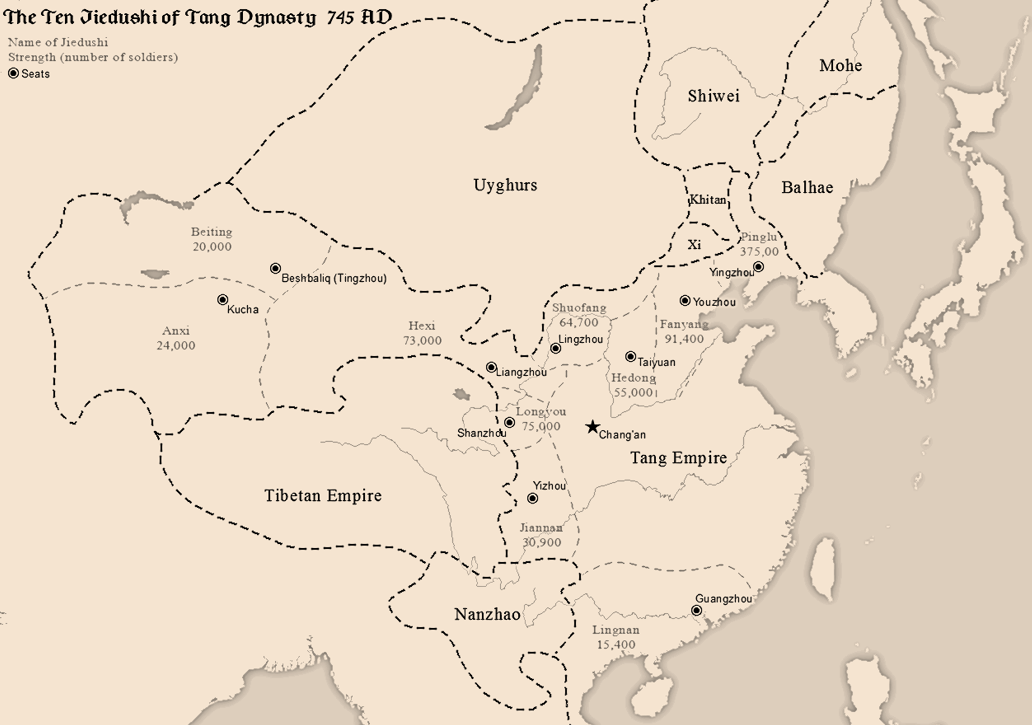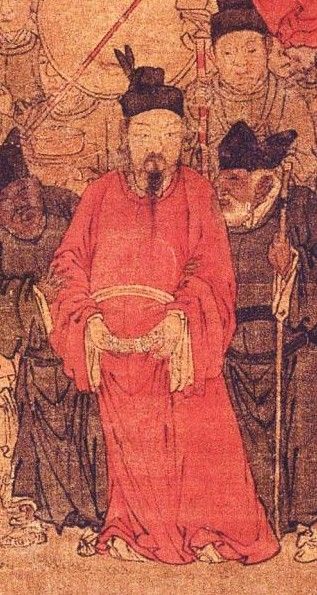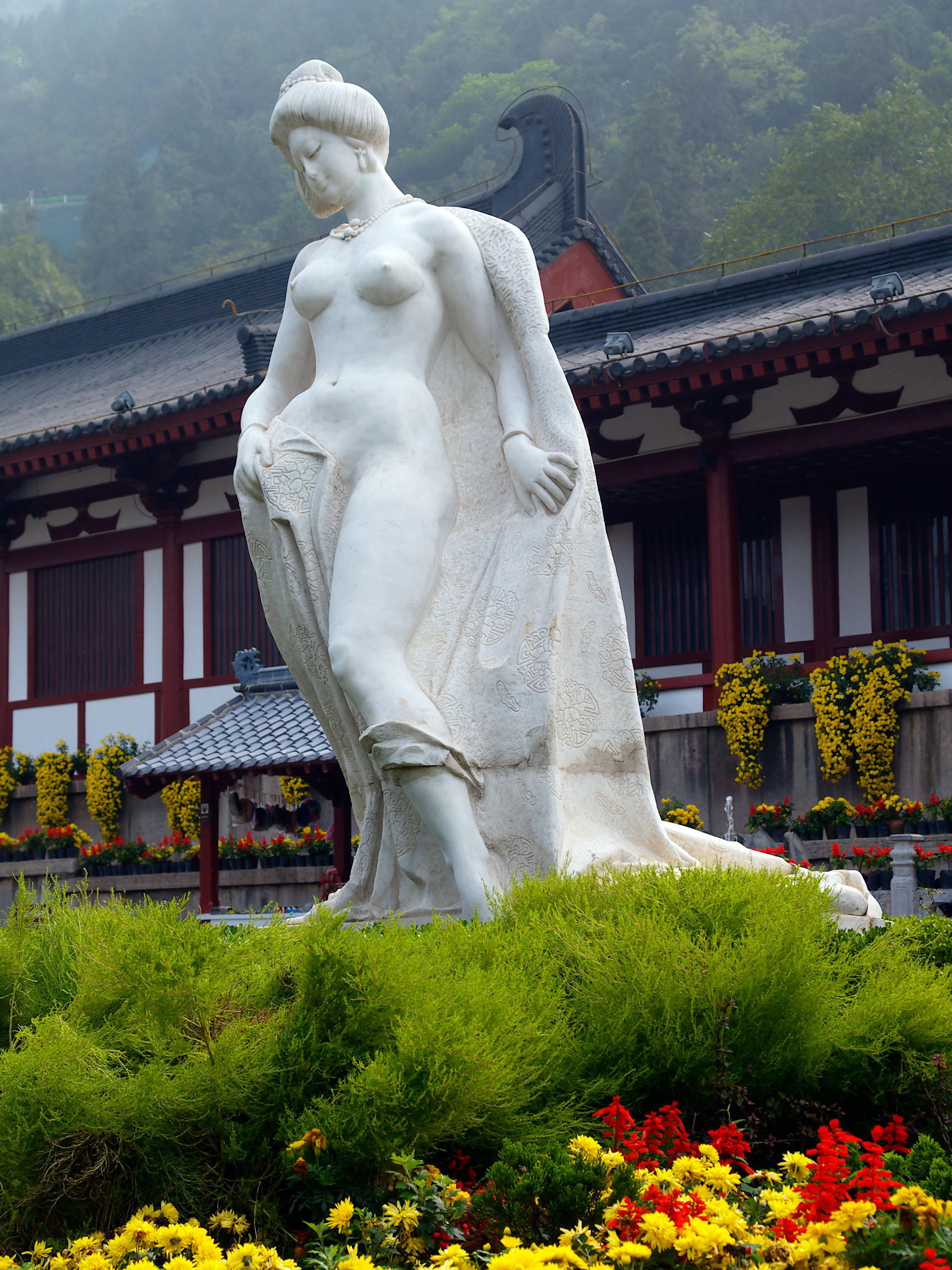|
Guo Ziyi
Guo Ziyi (Kuo Tzu-i; Traditional Chinese: йғӯеӯҗе„Җ, Simplified Chinese: йғӯеӯҗд»Ә, Hanyu Pinyin: GuЕҚ ZЗҗyГӯ, Wade-Giles: Kuo1 Tzu3-i2) (697 вҖ“ July 9, 781), posthumously Prince ZhЕҚngwЗ” of FГ©nyГЎng (), was a Chinese military general and politician who ended the An Lushan rebellion and participated in expeditions against the Uyghur Khaganate and Tibetan Empire. He was regarded as one of the most powerful Tang generals before and after the Anshi Rebellion. After his death he was deified in Chinese folk religion as the God of Wealth and Happiness (''Lu Star'' of Fu Lu Shou). Guo Ziyi is depicted in the Wu Shuang Pu (з„Ўйӣҷиӯң, Table of Peerless Heroes) by Jin Guliang. Family Parents * Mother: Unknown * Father: Guo Jingzi (йғӯ敬д№Ӣ) Wife and concubines * Lady Wang (зҺӢж°Ҹ), legal wife ** Guo Xi (йғӯжҷһ; 733вҖ“794), third son ** Guo Wu (йғӯжҷӨ), fifth son ** Guo Ai (йғӯжӣ–), sixth son ** Guo Shu (йғӯжӣҷ), seventh son ** Guo Ying (йғӯжҳ ), eighth son * Lady Zhang (еј ж°Ҹ), con ... [...More Info...] [...Related Items...] OR: [Wikipedia] [Google] [Baidu] |
Guo (surname)
"Guo", written in Chinese language, Chinese: wikt:йғӯ, йғӯ, is one of the most common Chinese surnames and means "the wall that surrounds a city" in Chinese. It can also be transliterated as Cok, Gou, Quo, Quach, Quek, Que, Keh, Kuo, Kwo, Kuoch, Kok, Koc, Kwee, Kwek, Kwik, Kwok, Kuok, Kuek, Gock, Koay, or Ker. The Korean equivalent is spelled Kwak (Korean surname), Kwak; the Vietnamese equivalent is Quach (Vietnamese surname), QuГЎch. The different ways of spelling this surname indicate the origin of the family. For example, the Cantonese "Kwok" originated in Hong Kong and the surrounding area. In the Philippines, the spelling is "Que", "Ke", "Quepe", and "Kepa". In 2019, Guo was the 16th most common surname in mainland China. Origins There are eight legendary origins of the Guo surname, which include a Persian (Hui people, Hui) origin, a Korean origin, and a Mongolian origin, as a result of sinicization. However, the majority of people bearing the surname Guo are descended f ... [...More Info...] [...Related Items...] OR: [Wikipedia] [Google] [Baidu] |
Jiedushi
The ''jiedushi'' (, Old Turkic: TarduЕҹ) or jiedu, was a regional military governor in China; the title was established in the Tang dynasty and abolished in the Yuan dynasty. The post of ''jiedushi'' has been translated as "military commissioner", " legate", or "regional commander". Originally introduced in 711 to counter external threats, the ''jiedushi'' were posts authorized with the supervision of a defense command often encompassing several prefectures, the ability to maintain their own armies, collect taxes and promote and appoint subordinates. Powerful ''jiedushi'' eventually became '' fanzhen'' rulers (''de facto'' warlords) and overrode the power of the central government of Tang. An early example of this was An Lushan, who was appointed ''jiedushi'' of three regions, which he used to start the An Lushan Rebellion that abruptly ended the golden age of the Tang dynasty. Even after the difficult suppression of that rebellion, some ''jiedushi'' such as the Three Fanz ... [...More Info...] [...Related Items...] OR: [Wikipedia] [Google] [Baidu] |
An Lushan
An Lushan (; 20th day of the 1st month (19 February) 703 вҖ“ 29 January 757) was a Chinese military general and rebel leader during the Tang dynasty and is primarily known for instigating the An Lushan Rebellion which devastated China and killed millions of people. An Lushan was of Sogdian and GГ¶ktГјrk origin,Yang, Zhijiu, "An Lushan". ''Encyclopedia of China'' (Chinese History Edition), 1st ed.Lin, TianweAn Lushan profile, ''Chinese Encyclopedia'' (Biography Edition; 1st ed.); accessed 3 August 2011.Zhong, Han. "Ah Lushan Dengzahu De Neiya Wenhua Beijing" ("The Cultural Background on An Lushan, etc in Inner Asia вҖ” With the Discussion on the Inner Asia-ized of Sute or Sogdian"). ''Journal of Chinese Historical Studies'' (2005); at least by adoption. He rose to prominence as a general by defending the northeastern Tang frontier from the Khitans and other threats. Through his frequent visits to Chang'an, the Tang capital, An Lushan managed to gain favour with Emperor Xuanzo ... [...More Info...] [...Related Items...] OR: [Wikipedia] [Google] [Baidu] |
An Lushan Rebellion
The An Lushan rebellion was a civil war in China that lasted from 755 to 763, at the approximate midpoint of the Tang dynasty (618вҖ“907). It began as a commandery rebellion attempting to overthrow and replace the Tang government with the rogue Yan dynasty. The rebels succeeded in capturing the imperial capital Chang'an after the emperor had fled to Sichuan, but eventually succumbed to internal divisions and counterattacks by the Tang and their allies. The rebellion spanned the reigns of three Tang emperors: Xuanzong, Suzong, and Daizong. On 16 December 755, An Lushan, the ''jiedushi'' of the Taiyuan Commandery, mobilized his army and marched to Fanyang. An Lushan led the rebellion for two years before he was assassinated by his son An Qingxu. Two years after An Qingxu's ascension, Shi Siming, the governor of Pinglu Commandery and a close ally of An Lushan, killed An Qingxu and usurped the leadership. Shi Siming ruled for two years, but was in turn killed by his own son ... [...More Info...] [...Related Items...] OR: [Wikipedia] [Google] [Baidu] |
Emperor Suzong Of Tang
Emperor Suzong of Tang (''yihai'' day, 711 вҖ“ 16 May 762; r. 756 вҖ“ 762), personal name Li Heng, nГ© Li Sisheng (), known as Li Jun () from 725 to 736, known as Li Yu () from 736 to 738, known briefly as Li Shao () in 738, was an emperor of the Chinese Tang dynasty and the son of Emperor Xuanzong. Suzong ascended the throne after his father fled to Sichuan during the An Lushan Rebellion in 756; Li Heng himself had fled in the opposite direction, to Lingwu, where he was declared emperor by the army. Much of Emperor Suzong's reign was spent in quelling the aforementioned rebellion, which was ultimately put down in 763 during the reign of his son Emperor Daizong. During Emperor Suzong's reign, the tradition of eunuchs becoming top-ranked officials began, with Li Fuguo becoming the commander of the imperial guards and possessing nearly absolute power near Emperor Suzong's reign. Li Fuguo allied and befriended Emperor Suzong's wife, Empress Zhang, at the beginning of Emp ... [...More Info...] [...Related Items...] OR: [Wikipedia] [Google] [Baidu] |
Lingwu
Lingwu (, Xiao'erjing: Щ„ЩҗШҰЩҚвҖҢЩҲЩҸ ШҙЩҗ) is a county-level city of Ningxia Hui Autonomous Region, Southwest China, it is under the administration of the prefecture-level city of Yinchuan. It is the most important industrial city of Ningxia. Lingwu spans an area of , and according to the 2010 Chinese census, Lingwu has a population of 261,677. Toponymy Lingwu was historically known as Lingzhou (, Xiao'erjing: Щ„ЩҗШҰЩҚвҖҢШ¬ЩҗЩҲЩ’). History During the Warring States period, the area was absorbed into the Qin dynasty under Beidi Commandery. The area was first incorporated into the Han dynasty in 191 BCE by Emperor Hui. In 437 CE, under the Northern Wei, the area was incorporated as . In 526 CE, Bogulu Town was renamed as Lingzhou. In 756 CE, during the Tang dynasty, Emperor Suzong fled to Lingzhou during the Anshi Rebellion, where he ascended the throne with the aid of loyal bureaucrats and military supporters, only notifying his father Xuanzong after the fact. Lingzh ... [...More Info...] [...Related Items...] OR: [Wikipedia] [Google] [Baidu] |
Li Guangbi
Li Guangbi (жқҺе…үејј; 708 вҖ“ August 15, 764), formally Prince Wumu of Linhuai (иҮЁж·®жӯҰз©ҶзҺӢ), was a Chinese military general, monarch, and politician during the Tang dynasty. He was of ethnic Khitan ancestry, and was instrumental in Tang's suppression of the Anshi Rebellion. Background Li Guangbi was born in 708, during the second reign of Emperor Zhongzong. His father, Li Kailuo (жқҺжҘ·жҙӣ), was a general of Khitan ancestry, whose achievements during the ''Kaiyuan'' era (713вҖ“741) of Emperor Zhongzong's nephew Emperor Xuanzong eventually led to his creation as the Duke of Ji Commandery. Li Guangbi's mother was Lady Li, a daughter of Li Kaigu. Li Guangbi was said to be careful in his behavior when young. He was capable in horsemanship and archery, and also studied the '' Book of Han''. He started his army service when young, and was said to be decisive, strict, and full of strategies. After his father died, he inherited the title of the Duke of Ji, and was prai ... [...More Info...] [...Related Items...] OR: [Wikipedia] [Google] [Baidu] |
Shi Siming
Shi Siming () (19th day of the 1st month, 703? вҖ“ 18 April 761), or Shi Sugan (), was a Chinese military general, monarch, and politician during the Tang dynasty who followed his childhood friend An Lushan in rebelling against Tang, and who later succeeded An Lushan's son An Qingxu as emperor of the Yan state that An Lushan established. Background It is not known when Shi Sugan was born, other than that he was born one day before his friend An Lushan and that they grew up together. He was of Tujue extraction, and was said to be thin with smooth skin, with an impatient disposition. After both he and An grew up, they were both known for their bravery. However, he was poor and of low social station, and was looked down by the people of his locale. However, a Lady Xin, a daughter of local gentry, insisted on marrying him despite her family's opposition, and she was eventually successful in doing so. Under Emperor Xuanzong's rule Shi Sugan first served under the Tang dynasty g ... [...More Info...] [...Related Items...] OR: [Wikipedia] [Google] [Baidu] |
Yang Guifei
Yang Yuhuan (; 719 вҖ“ 15 July 756Volume 218 of ''Zizhi Tongjian'' recorded that Yang was killed on the ''bing'shen'' day of the 6th month of the 1st year of the ''Zhi'de'' era of Tang Suzong's reign. This date corresponds to 15 Jul 756 on the Gregorian calendar.), often known as Yang Guifei (, with ''Guifei'' being the highest rank for Imperial Chinese harem system, imperial consorts during her time), and known briefly by the Taoist nun name Taizhen (), was the beloved consort of Emperor Xuanzong of Tang during his later years. She is known as one of the Four Beauties, Four Beauties of ancient China. During the An Lushan Rebellion, as Emperor Xuanzong and his cortege were fleeing from the capital Chang'an to Chengdu, the emperor's guards demanded that he put Yang to death because they blamed the rebellion on her cousin Yang Guozhong and the rest of her family. The emperor capitulated and reluctantly ordered his attendant Gao Lishi to supervise her forced suicide. Background Ya ... [...More Info...] [...Related Items...] OR: [Wikipedia] [Google] [Baidu] |
Emperor Xuanzong Of Tang
Emperor Xuanzong of Tang (; 8 September 685 вҖ“ 3 May 762), personal name Li Longji, was an Emperor of China, emperor of the Tang dynasty of China, reigning from 712 to 756. His reign of 44 years was the longest during the Tang dynasty. Through two palace coups, he seized the throne and inherited an empire still in its golden age. He was initially assisted by capable chancellors like Yao Chong, Song Jing and Zhang Yue (Tang dynasty), Zhang Yue who were already serving as government officials before Xuanzong ascended the throne. However, under Emperor Xuanzong, the empire reached its turning point and went into sharp decline and near collapse, due to numerous political missteps throughout his long reign, such as over-trusting chancellors Li Linfu, Yang Guozhong and general An Lushan, with Tang's golden age (metaphor), golden age ending in the An Lushan rebellion. Background Li Longji was born at the Tang dynasty eastern capital Luoyang in 685, during the first reign of his fat ... [...More Info...] [...Related Items...] OR: [Wikipedia] [Google] [Baidu] |
Yang Guozhong
Yang Guozhong () (died July 15, 756Volume 218 of ''Zizhi Tongjian'' recorded that Yang was killed on the ''bingshen'' day of the 6th month of the 1st year of the Zhide era of Tang Suzong's reign. This date corresponds to 15 Jul 756 on the Gregorian calendar.), nГ© Yang Zhao (), was a Chinese politician who served as principal chancellor of the Tang dynasty from 752 to 756, late in the reign of Emperor Xuanzong. Known in his youth as a gambler and wastrel, Yang rose rapidly to political power after his distant cousin, Yang Yuhuan, became Emperor Xuanzong's favorite consort in 744. His familial ties and skills as a financial administrator helped him navigate the tumultuous court politics of the late 740s and early 750s to become the emperor's leading chancellor in 752. While Yang enjoyed Emperor Xuanzong's trust, his competence as chancellor was questioned and he became entangled in a fierce rivalry with an erstwhile political ally, the general and imperial favorite An Lushan. Y ... [...More Info...] [...Related Items...] OR: [Wikipedia] [Google] [Baidu] |
Battle Of Qingbi
A battle is an occurrence of combat in warfare between opposing military units of any number or size. A war usually consists of multiple battles. In general, a battle is a military engagement that is well defined in duration, area, and force commitment. An engagement with only limited commitment between the forces and without decisive results is sometimes called a skirmish. The word "battle" can also be used infrequently to refer to an entire operational campaign, although this usage greatly diverges from its conventional or customary meaning. Generally, the word "battle" is used for such campaigns if referring to a protracted combat encounter in which either one or both of the combatants had the same methods, resources, and strategic objectives throughout the encounter. Some prominent examples of this would be the Battle of the Atlantic, Battle of Britain, and the Battle of France, all in World War II. Wars and military campaigns are guided by military strategy, whereas batt ... [...More Info...] [...Related Items...] OR: [Wikipedia] [Google] [Baidu] |






